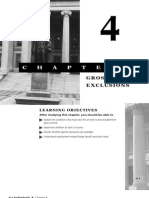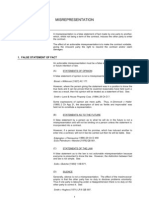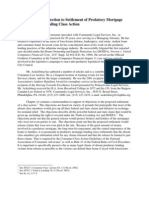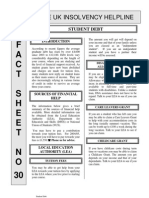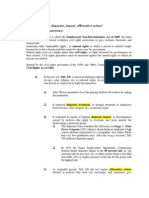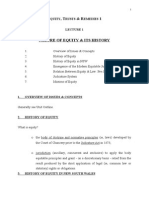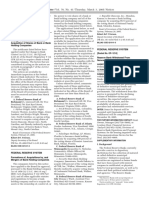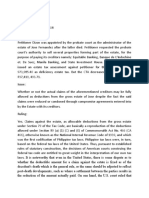7) Torts II: BBM Notes Compiled by Njihia Kaburu
7) Torts II: BBM Notes Compiled by Njihia Kaburu
Uploaded by
Francis Njihia KaburuCopyright:
Available Formats
7) Torts II: BBM Notes Compiled by Njihia Kaburu
7) Torts II: BBM Notes Compiled by Njihia Kaburu
Uploaded by
Francis Njihia KaburuOriginal Description:
Original Title
Copyright
Available Formats
Share this document
Did you find this document useful?
Is this content inappropriate?
Copyright:
Available Formats
7) Torts II: BBM Notes Compiled by Njihia Kaburu
7) Torts II: BBM Notes Compiled by Njihia Kaburu
Uploaded by
Francis Njihia KaburuCopyright:
Available Formats
BBM notes Compiled by Njihia Kaburu
7) Torts II i) The tort of Negligence ii) Elements of negligence iii) Damages for negligence iv) Professional negligence THE TORT OF NEGLIGENCE Negligence of course means carelessness, but in 1934 Lord right said! "#n strict legal anal$sis, negligence means more than heedless or careless conduct, %hether in omission or commission! it &ro&erl$ connotes the com&le' conce&t of dut$, breach and damage thereb$ suffered b$ the &erson to %hom the dut$ %as o%ing() * Lochgelly Iron and Coal Co v McMullan +1934, -. 1 at /0) This sentence enca&sulates the traditional tri&artite structure of negligence as a tort( #t is not enough to sho% that defendant %as careless! the tort involves a breach of duty that causes damage that is not too remote( Defn: carelessl$ carr$ing out an act and brea1ing a legal dut$ of care o%ed to another causing them loss or damage( Thus2 to succeed in an action for negligence, the claimant must &rove that2 The defendant had a duty of care to avoid causing in3ur$, damage or loss( That there %as breach of that duty b$ the defendant( #n conse4uence, the claimant suffered n!ury" dama#e or $oss( Duty of Care 5or one to succeed in negligence $ou must first &rove that the defendant o%ed $ou a dut$ of care( 5or centuries the la% has recognised relationshi&s in %hich one &erson o%es a dut$ to another( hat %as lac1ing %as a #enera$ %r nc %$e on ho% to assess this dut$( T%o &rinci&les have develo&ed over the time( The Neighbour Princi&le *6asic 7ule) This %as develo&ed in the landmar1 case of2 Donoghue v Stevenson 1932 - &urchased a bottle of ginger beer for consum&tion b$ 6( 6 dran1 all the contents, %hich contained the remains of a decom&osed snail and became ill( 8e sued the manufacturer( The manufacturer argued that there %as no contract bet%een himself and 6 and so no dut$ of care( 8ELD! Ever$ &erson o%es a dut$ of care to his "neighbour), to &ersons "so closel$ and directl$ affected b$ m$ act that # ought to reasonabl$ to have them in contem&lation as being affected() #n la$ing the &rinci&le, the 3udges said2 "The rule that you are to love your neighbour becomes in la ! you must not in"ure your neighbour# and the la yer$s %uestion! &ho is my neighbour' receives a restricted re(ly) *ou must ta+e reasonable care to avoid acts or omissions hich you can reasonably ,oresee ould be li+ely to in"ure your neighbour) &ho! then! in la is my neighbour' The ans er seems to be - (ersons ho are so closely and directly a,,ected by my act that I ought reasonably to have them in contem(lation as being so a,,ected hen I am directing my mind to the acts or omissions hich are called in %uestion)" The current test! foresight, &ro'imit$ and fairness The test is no% stated in this form( The claimant has to sho% three things if there is to be a dut$ of care! #t %as reasonabl$ foreseeable that a &erson in the claimant)s &osition %ould be in3ured( There %as sufficient &ro'imit$ bet%een the &arties( #t is fair, 3ust and reasonable to im&ose liabilit$ i(e( should the dut$ be restricted9limited for reasons of economic, social or &ublic &olic$:
1
BBM notes Compiled by Njihia Kaburu
;5oreseeabilit$; means %hether a h$&othetical ;reasonable &erson; %ould have foreseen damage in the circumstances( ;Pro'imit$; is shorthand for Lord -t1in;s neighbour &rinci&le( #t means that there must be legal &ro'imit$, i(e( a legal relationshi& bet%een the &arties from %hich the la% %ill attribute a dut$ of care( There is no single case identified %ith this test, but one of its best e'&ositions is b$ 6ingham L< in the .ourt of -&&eal in Ca(aro Industries v Dic+man +19=9, >6 ?03 at ?@=A?=B( &reach of that duty The second element that a claimant in negligence must &rove is that the dut$ of care %as breached( This is to be then assessed using a certain standard of care( The basic rule The basic rule is that the defendant must conform to the standard of care e'&ected of a reasonable &erson( "Negligence is the omission to do something %hich a reasonable man guided u&on those considerations %hich ordinaril$ regulate the conduct of human affairs, %ould do, or doing something %hich a reasonable and &rudent man %ould not do() *.lythe v .irmingham &ater or+s *1=0?) 11 E'ch @=1) /rdinary (erson in ordinary circumstances Cne of the fe% cases in %hich the 8ouse of Lords has had to consider the behaviour of an ordinar$ &erson in ordinar$ circumstances *not involving s&ecial s1ill or 1no%ledge) is 0lasgo Cor(oration v Muir +1943, -. 44=( Lord Dacmillan highlighted t%o im&ortant as&ects of the test! *a) "The standard of foresight of the reasonable man is, in one sense, an im&ersonal test( #t eliminates the &ersonal e4uation and is inde&endent of the idios$ncrasies of the &articular &erson %hose conduct is in 4uestion() #t is an ob3ective test( The abstract reasonable &erson is &ut into the shoes of the defendant, %ho is e'&ected to have the same general 1no%ledge and understanding of ris1s *sa$, that ic$ roads are sli&&er$ or that children ma$ get u& to mischief) as the reasonable &erson( The actual defendant ma$ be stu&ider or more ignorant, or ma$ be cleverer or more 1no%ledgeable, but is still 3udged b$ this abstract im&ersonal standard( *b) "#t is still left to the 3udge to decide %hat, in the circumstances of the &articular case, the reasonable man %ould have had in contem&lation( 8ere there is room for diversit$ of vie%( hat to one 3udge ma$ seem farA fetched ma$ seem to another both natural and &robable() The outcome is therefore to that e'tent un&redictable even in the tin$ minorit$ of cases that are resolved in court( De,endants ith s(ecial s+ills or %uali,ications Dost of the difficult re&orted cases ho%ever involve defendants %ith s&ecial s1ills or 4ualifications( #t %ould be sill$ to as1 %hether a reasonable "&erson) %ould have driven the car, removed the a&&endi' or designed the building in the same %a$ as the actual motorist, surgeon or architect %ho is being sued( #n such cases the defendant is to be com&ared to a reasonable &erson %ith the relevant s1ill or 4ualification( This is not al%a$s as eas$ as it might be( 5or one thing, there is sometimes doubt as to e'actl$ %hat s1ill or 4ualifications the defendant &rofesses to have( 5or another, there ma$ be doubt as to %hether a large grou& *sa$ car drivers or doctors) should be subA divided into smaller categories for the &ur&ose of com&arison %ith reasonable members of the grou&( Dan$ cases involve car drivers( The onl$ standard of care is that of a reasonable driver, %hether the actual driver is highl$ e'&erienced, ne%l$ 4ualified or even 3ust a learner( #t is irrelevant that the learner driver defendant %as doing as %ell as she could, given her lac1 of e'&erience, if a reasonable driver %ould have done better(
2
BBM notes Compiled by Njihia Kaburu
-dditional factors Cther factors to consider in assessing %hether the defendant breached his9her dut$ of care include2 Probabilit$ of in3ur$! %hen the ris1 and &robabilit$ of in3ur$ is high, the higher the standard of care e'&ected of a reasonable man( E(g %hen dealing %ith vulnerable classes of &eo&le li1e children, %arning notices %ill not be sufficient( Eeriousness of the ris1! the old or $oung ma$ be &rone to more serious in3ur$ than the rest( Fou must ta1e $our victims as $ou found them2 and so %hen the ris1 of serious in3ur$ is higher, the dut$ of care re4uired is raised( 1aris v Ste(ney .orough Council P %as em&lo$ed b$ G on vehicle maintenance( P had alread$ lost one e$e( Eince ris1 to e$e in3ur$ %as small, it %as not the normal &ractice to issue and insist on googles for &rotection( - chi& of metal fle% to P)s good e$e rendering him &ermanentl$ blind( 8ELD! there %as a higher standard of care o%ed to P because an in3ur$ to his remaining good e$e %ould blind him2 thus G liable( Practicalit$ and .ost! #t is not al%a$s &ossible to ta1e all &recautions( here the cost or disru&tion caused to eliminate the danger far e'ceeds the ris1 of it occurring, it is li1el$ that defendants %ill be found not to have breached their dut$ if not im&lement them( Latimer v 23C Ltd The defendants o%ned a factor$ that became flooded after a &eriod of heav$ rain, %ith the %ater being mi'ed u& %ith oil on the factor$ floor leading to sli&&eriness( Ea%dust %as a&&lied to the ma3orit$ of areas affected, but the claimant sli&&ed in one of the fe% untreated areas and fell( 8ELD! the defendants tried their best to minimise the ris1( To eliminate it allAtogether, the$ %ould need to close the factor$2 %hich %ould be e'tremel$ e'&ensive( .ommon Practice! one %ill have met his9her dut$ of care if he9she can &rove that their actions %ere in line %ith common &ractice or customs of a &articular trade9industr$ or a &articular &lace( Eocial 6enefit! some instances of ris1$ conduct are e'cused if the$ confer some social benefit( E(g( fire engines, ambulance etc Professions and E1ill! &ersons %ho hold out themselves to &ossess a &articular s1ill are 3udged on %hat a reasonable &erson &ossessing the same s1ill %ould do in the situation( Dost &rofessions set their o%n standards of care for their members %hch form the basis for assessment( 7es #&sa Lo4uitr Her$ often the claimant ma$ not be able to find out %hat ha&&ened( - &ar1ed car, for e'am&le, ma$ have moved off %ithout %arning do%n a hill( -ll the claimant can do is sho% that such a thing does not normall$ ha&&en unless there has been negligence( The claimant can then ma1e use of a rule of the la% of evidence called res i(sa lo%uitur *the facts s&ea1 for themselves)( Fou must as1 $ourself! *a) %hen it is legitimate to use the ma'im *b) %hat the effect of invo1ing it is( #t)s onl$ legitimate to use this &rinci&le in the follo%ing instances2 The thing %hich caused the in3ur$ %as under management and control of the defendant( The accident %as such that %ould not occur if those in control used &ro&er care( Cnce successfull$ invo1ed, the burden of &roof is reversed and the defendants must &rove that the$ %ere not negligent( E(g 4ichley v 5ould 1967 - car s1idded to the %rong side of the road I it %as enough to indicate dangerous driving( Mahon v /sborne 1939 - surgeon %as re4uired to &rove that leaving a s%ab inside a &atient after an o&eration %as not negligent(
3
BBM notes Compiled by Njihia Kaburu
Fou should be %arned that this doctrine a&&lies onl$ e'ce&tionall$( Fou should not ma1e use of it in ans%ering 4uestions unless there is a clear suggestion that there is no e'&lanation for %hat has ha&&ened and the onl$ inference is that the defendant must have been negligent( Causat on and Remoteness of Dama#e The third as&ect that a claimant must &rove is that he suffered in3ur$, damage or loss as a result of the defendant)s actions( This raises t%o im&ortant 4uestions2 hat amounts to damage, in3ur$ or loss hen can it be recovered Dama#e'Loss - &erson %ill onl$ be com&ensated if he has suffered actual loss, in3ur$, damage or harm as a result of the defendants) actions( E'am&les of such loss include2 Personal in3ur$ Damage to &ro&ert$ 5inancial loss directl$ connected to &ersonal in3ur$ e(g( loss of earnings Pure financial loss is rarel$ recoverable for &olic$ reasons( (hen can t be reco)ered* Cnce a breach of dut$ has been established, the claimant must therefore also sho% that the breach has resulted in in3ur$ or damage *the causat on issue) and that the in3ur$ or damage is sufficientl$ closel$ connected to the breach *the remoteness issue)( This raises t%o &arameters2 .ausation 7emoteness Causat on 8arm must have been caused b$ the defendant)s actions( Fou must al%a$s remember to lin1 the tort *i(e( the breach of dut$ in the case of negligence) and not merel$ the defendant to the damage( 5or e'am&le, a bab$ has brain damage! it has recentl$ been vaccinated( 5or a claim in negligence to succeed2 i(e( alleging that a doctor in breach of the dut$ of care failed to carr$ out &ro&er tests to discover %hether the bab$ had an allerg$ to the vaccine2 #t %ill then be necessar$, in addition to sho%ing that the )acc ne caused the damage, to sho% that the breach of duty caused the damage( #f the &ro&er tests carefull$ administered %ould not have revealed the allerg$, then the bab$ %ould still have been damaged and the breach of dut$ %ould not be a cause of the brain damage( To &rove causation, the courts have develo&ed a rule2 6ut 5or Test *6asic 7ule) The basic rule ma$ be stated &ositivel$ or negativel$( #f the damage %ould still have occurred, even if the defendant had not bro1en the dut$ of care, then the breach did not cause the damage( #f the damage %ould not have occurred but ,or the defendant)s breach of dut$, then the breach of dut$ is a cause of the damage( 5or this reason, the basic rule is often referred to as the "but for test)( #ts main &ur&ose is to e'clude things that have no bearing on the damage( #t is for the claimant to sho% that the breach of dut$ %as the cause of the damage, and not for the defendant to sho% that the breach of dut$ %as not the cause of the damage( .arnett v 8ensington and Chelsea 9os(ital +19?9, 1 >6 4/=(
BBM notes Compiled by Njihia Kaburu
- casualt$ doctor sent a &atient home %ithout treatment, referring him to his o%n doctor( The &atient died of arsenic &oisoning( 8ELD! %hile the doctor %as negligent, arsenic &oisoning %as so serious that the &atient %ould have died an$%a$( #n a number of situations the a&&lication of the "but for) test %ould lead to outcomes that %ould be absurd or arguabl$ un3ust( The courts have in some of these cases been &re&ared to abandon or modif$ that test( These are called s&ecial &roblems in causation including2 Dulti&le causes This occurs %here there are a number of &ossible causes of in3ur$ including the negligent act( The courts are left to decide on the facts of each case %hether the negligent act %as the most li1el$ cause of the in3ur$( &ilsher v 3sse: 292 The health authorit$ had failed to detect that the catheter had been %rongl$ inserted and therefore the &remature bab$ received too much o'$gen( That %as held to be negligent( E'cess o'$gen can cause blindness in &remature infants( #t is ho%ever onl$ one of several causes2 including si' others( 8ad it been the cause in the case of ilsher: The 8ouse of Lords held that this had not been established on the balance of &robabilities, so that there %as no direct causal lin1( The courts are a bit fle'ible in a&&l$ing legal &rinci&les2 es&eciall$ in e+ce%t ona$ cases( 5airchild v 0lenhaven 5uneral Services Ltd ; /thers 2<<2 The claimants all suffered from a form of cancer undoubtedl$ caused b$ asbestos dust( The &rocess b$ %hich the asbestos caused the cancer %as not entirel$ understood, but it might be that one fibre or grou& of fibres triggered the cancer, &erha&s some $ears later! if so, once the triggering had occurred, e'&osure to other fibres %ould not ma1e matters an$ %orse, and sto&&ing the e'&osure to asbestos %ould not ma1e matters an$ better( The claimants had all %or1ed for more than one em&lo$er over man$ $ears( -ll the em&lo$ers had in breach of their dut$ e'&osed the claimants to asbestos fibres( #t %as im&ossible to form an$ vie% about %hose fibres had triggered the cancer( The 8ouse of Lords held that the$ %ere all liable, so long as the evidence remained inconclusive( #ntervening events *Novus actus interveniens) .ourts %ill onl$ im&art liabilit$ %here there is a course of events that are a &robable result of the defendant)s actions( Defendants %ill not be liable for damage %hen the chain of events id bro1en( There are 3 t$&es of intervening events %hich ma$ brea1 the chain of causation2 1) 2cts o, the claimant #f the claimant suffers further in3ur$ as a result of his o%n actions, there %ill be a brea1 in the chain of causation onl$ if the claimant acted unreasonabl$( #f the actions are reasonable and in the ordinar$ course of things, an act b$ the claimant %ill not brea1 the chain( Mc8e v 9olland! 9annen ; Cubitts ; Co =1969> 3 2ll 34 1621 The claimant had a leg in3ur$ %hich %as &rone to causing his leg to give a%a$ from time to time( hile at %or1, he failed to as1 for assistance %hen negotiating a flight of stairs, he fell and %as in3ured as a result( 8ELD! the fact that the claimant failed to see1 assistance %as unreasonable and %as sufficient to brea1 the chain of causalit$( 2) 2ct o, a third (arty here a third &art$ intervenes in the course of events, the defendant %ill normall$ onl$ be liable for damage until the intervention(
Lamb v Camden L.C 19?1
5
BBM notes Compiled by Njihia Kaburu
The defendant negligentl$ caused a house to be damaged and as a result %as vacated a%aiting re&airs2 %hich gave chance to s4uatters to invade and cause further damage to the building( 8ELD! the defendant %as not liable for the additional damage caused b$ the invasion b$ s4uatters( 3) @atural events These do not automaticall$ brea1 the chain of causation( #f a breach of a dut$ of care &uts the claimant in ris1 of additional damage being caused b$ natural events, causation chain %ill not be bro1en( 8o%ever, if the natural event is unforeseeable, the chain %ill be henceforth bro1en( Carslogie Steamshi( Co v 4oyal @or egian 0overnment =1972> 1 2ll 34 2< - shi& damaged b$ defendant)s negligence %as further damaged due to severe %eather conditions on %a$ to re&air, %hich caused more dela$ in re&airing the shi&( .laimants claimed for loss of &rofits during re&air &eriod 8ELD! the defendants %ere onl$ held liable for loss incurred for their %rongful act onl$( The damage b$ %eather had made the shi& unsea%orth$, intervening and brea1ing causation chain so that there %as no damages for loss of &rofit( Remoteness of Dama#e -t one time the test of remoteness of damage in the tort of negligence %as said to be %hether the damage %as the direct conse4uence of the breach of dut$( #f it %as merel$ indirect, &articularl$ if there %as something %hich "bro1e the chain of causation), then the defendant %as not liable( This test %as &articularl$ associated %ith the decision of the .ourt of -&&eal in 4e 1olemis +19/1, 3 G6 0?B( 8o%ever, this changed( Eince 19?4 the acce&ted test has been that the defendant is liable for damage onl$ if it %as the ,oreseeable conse4uence of the breach of dut$( This %as decided in the case2 The &agon Mound A@o 1B +19?1, 1 -. 3==( 5urnace oil had been negligentl$ s&illed from a shi& in E$dne$ 8arbour( The oil had been carried to nearb$ doc1s %here %elding o&erations %ere in &rogress( - &iece of cotton %aste caught fire, the tem&erature %as raised sufficientl$ to ignite the oil and the resulting fire destro$ed the doc1s and shi&s moored there( 8ELD! The Priv$ .ouncil held that the defendants should be liable onl$ for %hat could reasonabl$ have been foreseen( The Priv$ .ouncil gave t%o reasons( - test of foreseeabilit$ %as *a) sim&ler and *b) more 3ust, because it %as unfair to hold a careless defendant liable for more than could have been foreseen %hen and if he thought about the conse4uences before committing the act of negligence( "#t is ho&ed that the la% %ill thereb$ be sim&lified and that, in some cases at least, &al&able in3ustice %ill be avoided() * (er Hiscount Eimonds)( #n this case, the foreseeable damage %as &ollution and not fire( The main issue is foreseeabilit$ of harm( The nature and e'tent of it is irrelevant as far as the s&ecific 1ind of harm %as foreseeable( Colley v Sutton London .orough Council +/BBB, 1 L7 1B=/( The defendant council had in breach of dut$ failed after several months to remove a derelict cabin cruiser that had been abandoned on its land( The issue %as %hether the council could foresee onl$ that small children %ould be in3ured b$ clambering over it, or %hether *as actuall$ ha&&ened) teenaged children %ould be in3ured b$ 3ac1ing it u& and %or1ing underneath it in order to ma1e it sea%orth$( This is in the end a matter of 3udgment Jthe 8ouse of Lords unanimousl$ held that it %as( Eince the$ 1ne% children regularl$ &la$ed in the field, the$ should have foreseen harm to children( ROFE,,ION-L NEGLIGENCE Professionals are individuals and organisations %ho have a s&ecial relationshi& %ith their clients and those %ho rel$ on their %or1( This is because the$ act in an e'&ert ca&acit$( Professionals are on man$ occasions called u&on to give advice( Ehould this advice turn out to be %rong, do these &rofessionals o%e a dut$ of care: .an the$ be held liable:
BBM notes Compiled by Njihia Kaburu
5or long times, the onl$ la% that remained that could hold such liable %as the normal &rinci&les of tort la% including Donoghue v Stevenson and 2nns v Merton London .orough Council( These onl$ hel&ed cover negligent misstatements that did not cause financial loss( 8o% about those that caused it: E&ecial 7elationshi& 7ecover$ for negligent misstatements %as limited to situations %here there e'isted a contractual or fiduciar$ relationshi& bet%een the &arties( 8o%ever, Lord Denning in 1901 &ro&osed another test %hich %as not immediatel$ acce&ted( This %as in2 Candler v Crane! Christmas ; Co 1971 - bad investment %as made based on negligentl$ &re&ared accounts( The investors claimed for negligent misstatement( #n his dissenting 3udgment, Lord Denning held that a &erson %as liable for negligent misstatements if there e'isted a s&ecial relationshi&( To establish this relationshi&, the &erson %ho made the statement must have done so in some &rofessional or e'&ert ca&acit$ %hich made it li1el$ that others %ould rel$ on %hat he said e(g( accountant, ban1er, surve$or etc( Cn accountants, Lord Denning said that the$ o%e a dut$ of care to not onl$ their clients, but all those %hom the$ 1no% %ill rel$ on their accounts in the transactions for %hich those accounts are &re&ared( 8o%ever, his %as onl$ a dissenting 3udgment and the .ourt of -&&eal held the accountants not liable( T%elve $ears later, s&ecial relationshi& %as acce&ted as a valid test( This led to a ne% 3udicial a&&roach to cases involving negligent misstatements( This %as in the case of2 9edley .yrne ; Co v 9eller ; 1artners Ltd +19?4, -. 4?0( The claimants through their ban1ers as1ed the defendants for advice about the credit%orthiness of one of the latter)s customers( The defendants gave a reasonabl$ favourable re&l$, and the claimants e'tended credit to the customers and suffered losses in conse4uence( The 8ouse of Lords held that in &rinci&le the defendants o%ed a dut$ of care to the claimants and %ould have been liable to them for the resulting losses if the$ had not given the advice "%ithout res&onsibilit$ on our &art)( 5or the moment $ou can ignore the &oint about "%ithout res&onsibilit$) and consider the issues of &rinci&le( The case &rofoundl$ changed the la% in t%o res&ects! *a) The defendants %ere held to o%e a dut$ to ta1e care in the advice or information that the$ gave *b) That dut$ e'tended to &urel$ economic losses( 8o%ever, for one to succeed in such a claim, there a&&ears to be three re4uirements2 a) The claimant relied on the defendant;s s1ill and 3udgment or his abilit$ to ma1e careful en4uir$2 *b) The defendant 1ne%, or ought reasonabl$ to have 1no%n, that the claimant %as rel$ing on him2 and *c) #t %as reasonable in the circumstances for the claimant to rel$ on the defendant( 7easonable foresight Cver time, the courts e'tended &otential liabilit$ and started to ta1e account of third &arties not 1no%n to the adviser( This %as stated in2 C3. 5asteners Ltd v Mar+s! .loom ; Co The defendants *accountants) &re&ared audited accounts sho%ing overAvalued stoc1 hence inflated &rofit( The auditors %ere a%are of li4uidit$ &roblems in the com&an$ and that it %as see1ing outside financing( The claimants too1 over the com&an$ for nominal amounts so that the$ could obtain services of the com&an$)s t%o directors( D6 never disclosed to <E6 that the stoc1s %ere inflated and on realising this, <E6 sued D6 claiming2 that the accounts %ere &re&ared negligentl$, the$ had relied on those accounts, %ould not have invested if the$ 1ne% the com&an$)s true &osition and D6 o%ed a dut$ of acre to all &ersons the$ could reasonabl$ foresee that the$ %ould rel$ on the accounts( 8ELD2 D6 o%ed a dut$ of care through foresight and had been negligent in &reå the accounts( 8o%ever, even though <E6 had relied on the accounts, the$ %ould not have acted differentl$ if the$ 1ne% the true &osition of the com&an$ because the$ reall$ %anted the directors and not the com&an$(
7
BBM notes Compiled by Njihia Kaburu
Kse to %hich the statement is to be &ut Eince <E6 fasteners, courts are reluctant to a&&l$ the foreseabilit$ test but have loo1ed at %hether the adviser has 1no%ledge of the user and the use to %hich the statement %ill be &ut( Ca(aro Industries v Dic+man +199B, / -. ?B0( .a&aro2 %hich alread$ held shares in 5idelit$ Plc bought more shares and even launched a ta1eAover bid after seeing accounts &re&ared b$ the defendants2 re&orting a &rofit of 1(3 million &ounds( .a&aro claimed from the auditors because the accounts should have sho%n a loss of 4BB,BBB &ounds( .a&aro argued that the auditors o%ed a dut$ of care to investors and &otential investors for the audit( 8ELD2 the firm of accountants %ho had carried out a statutor$ audit of a com&an$ onl$ o%ed a dut$ to the shareholders as o%ners of the com&an$ but not to the claimants %ho launched a ta1eAover bid for the com&an$ on the strength of the accounts( The 8ouse of Lord in .a&aro distinguished to instances facing a &rofessional adviser2 Preå information in the 1no%ledge that a &articular &erson %as contem&lating a transaction and %ould rel$ on the information in deciding %hether or not to &roceed %ith the transactionA "s&ecial relationshi&() Preå a statement for general circulation, %hich could foreseeabl$ be relied u&on b$ &ersons un1no%n to the &rofessional for a variet$ of different &ur&oses( The ma3or holding %as that auditors o%e no dut$ of care to the &ublic at large %ho rel$ on an audit re&ort %hen deciding to invest or even e'isting shareholders %anting to &urchase more shares( 5oreseeabilit$, Pro'imit$ and 5airness Cver time, courts have held that its necessar$ to e'amine several factors in deciding cases of &rofessional negligence( This %as stated in2 Mc @aughton ACamesB 1a(ers 0rou( Ltd v 9ic+s 2nderson ; Co 1991 The courts stated that it %as necessar$ to e'amine the case in light of foreseeabilit$, &ro'imit$ and fairness( Lord <ustice Neill set out further matters to be considered including2 The &ur&ose for %hich the statement %as made The 7elationshi& bet%een the ma1er of the statement, the reci&ient and an$ third &art$( The &ur&ose for %hich the statement %as communicated( The siLe of an$ class to %hich the reci&ient belonged( The state of 1no%ledge of the ma1er( -n$ reliance b$ the reci&ient( NonAaudit role The dut$ of care of accountants is held to be higher %hen advising on ta1eAovers than %hen auditing( The directors and financial advisors of teh target com&an$ in a contested ta1eAover bid o%e a dut$ of care to the 1no%n ta1eover bidder in res&ect of financial statements &re&ared for &ur&oses of contesting the bid( -fter .a&aro 7ecent cases have highlighted the need for accountants and auditors to be careful in evaluation of circumstances %hen giving financial advice( The need to issue a disclaimer9e'clusion clause has been em&hasised( 2DT Ltd v .D/ .inder 9amlyn 1997 6DC %ere 3oint auditors of 6EM( #n Cctober 19=9, 6EM)s accounts for $ear ended 3B <une 19=9 %ere &ublished %ith 6DC signing that the$ reflected a true and fair vie% of 6EM)s &osition( -DT as &ossible bu$ers of 6EM called 6DC senior audit &artner to a meeting in <anuar$ 199B, %here the &artner confirmed that he stood b$ the 19=9 audit( -DT bought the com&an$ for 1B0 million &ounds( #t %as later discovered that 6EM)s true value %as 4B million &ounds( -DT claimed the difference *?0m) &lus interest( 8ELD underl$ing audit %or1 had been carried out negligentl$ and so 6DC %ere liable for ?0 million &ounds( The
8
BBM notes Compiled by Njihia Kaburu
court held that auditors and accountants %ere under a higher standard of care %hen advising on com&an$ ac4uisitions since the losses can be much greater( 6DC assumed vicarious liabilit$ for its &artner)s statements( -nother case has tested the court)s inter&retation2 @40 D .acon and &oodro and 3rnst ; *oung N7M alleged that defendants had failed to &oint out that com&anies it %as targeting to invest in %ould suffer huge reAinsurance losses2 and %hether these could be &rotected against( The$ sued defendants as financial advisers for overA&a$ing //0 million &ounds for these com&anies( 8ELD2 though its true that accountants o%e a higher standard of care %hile advising on ta1eovers due to &otential losses, the$ had met this standard in this case for the advice given %as e4ual to %hat an$ com&etent &rofessional %ould have given( 5urther, the &laintiffs %ould have still bought the com&anies( 5or grou& situations, there has been further clarification in form of t%o im&ortant cases2 .arings 1lc D Coo(ers ; Lybrand 6arings &lc colla&sed in 1990 after lossAma1ing trader b$ the general manager of its Einga&ore subsidiar$ 65E2 %hich %as audited b$ the defendants( The defendants had &rovided 6arings directors %ith consolidation schedules and a co&$ of the audited re&ort( The defendants argued that the$ onl$ o%ed a dut$ of care to 65E and not 6arings( 8ELD2 the defendants must have 1no%n that their audit re&ort and consolidation schedules %ould be relied on at grou& level and so the$ o%ed a dut$ of care to 6arings( .CCI A/verseasB Ltd D 3rnst ; &hinney 199E The defendants audited the grou& accounts but not of the claimant subsidiar$( The claimants ho%ever claimed that the auditors o%e a dut$ of care to them( 8ELD2 No dut$ of care %as o%ed to the subsidiar$ because no s&ecific information is normall$ channelled do%n b$ a holding com&an$ to the com&an$)s subsidiaries( Limiting Liabilit$: Due to &otential liabilit$ of auditors, auditing firms have been e'&loring %a$s of limiting their liabilit$( The Limited Liabilit$ Partnershi&s -ct /BBB hel&ed such firms in limiting their liabilit$( The liabilit$ of audit &artners can no% be limited( #n addition, several firms have incor&orated their audit &ractices *registered them into com&anies)2 to en3o$ limited liabilit$( DEFENCE, TO NEGLIGENCE There are several defences available to a claim of negligence( These are2 .ontributor$ Negligence The courts ma$ reduce the damages to be &aid b$ the claimant if the defendant establishes that the$ contributed to their o%n in3ur$ or loss( This is 1no%n as contributor$ negligence( Sayers v 9arlo FDC 197? The claimant %as in3ured %hile tr$ing to climb out of a &ublic toilet cubicle that had defective loc1( 8ELD! the claimant had contributed to her in3uries b$ the method she used to climb out( #f the defendant can &rove that the claimant %as &artiall$ at fault2 damages are reduced b$ a &ercentage that is 3ust and reasonable based on the claimants share of the blame( #t ranges normall$ from 1BA@0N( 8o%ever sometimes, the$ ma$ be reduced u& to 1BBN2 leaving the claimant not liable( Holenti NonA5it #n3uria
9
BBM notes Compiled by Njihia Kaburu
The defence is called volenti non fit in3uria *damage is not done to someone %ho consents) and the claimant is said to be volens *%illing)( #t means that both &arties have voluntaril$ consented to the ris19in3ur$( #t ma$ be either e'&ress *b$ %ords9agreement) or im&lied from the conduct of &ersons involved( ICI v Shat ell The claimant and his brother disregarded safet$ &recautions %hile using detonators, thus in3uring the claimant( 8ELD! b$ not follo%ing safet$ &recautions, the$ had voluntaril$ consented to in3ur$( The claimant must be full$ informed of the ris1s before he consents to them( #m&lied consent is thus rare( Dann v 9amilton - girl &assenger in a vehicle driven b$ a drun1 &erson still succeeded in claim for negligence( Though she %as a%are of the ris1, there %as no evidence she %illingl$ consented to the ris1(
10
You might also like
- Handout 1 - Homicide OffencesDocument20 pagesHandout 1 - Homicide OffencesFrancis Njihia Kaburu75% (4)
- LSK Conditions of SaleDocument13 pagesLSK Conditions of SaleFrancis Njihia Kaburu0% (1)
- California Bar Exam Lecture Notes - Professional ResponsibilityDocument18 pagesCalifornia Bar Exam Lecture Notes - Professional ResponsibilityLal LegalNo ratings yet
- Concept of Land Ownership in KenyaDocument14 pagesConcept of Land Ownership in KenyaFrancis Njihia Kaburu100% (1)
- S5 Worksheet - Biz LawDocument5 pagesS5 Worksheet - Biz LawAndreas WiliaNo ratings yet
- AAP v. Golden Bear Realty Order Granting Motion For Preliminary InjunctionDocument9 pagesAAP v. Golden Bear Realty Order Granting Motion For Preliminary InjunctionSchneider Rothman IP Law GroupNo ratings yet
- Agency: REG - Notes Chapter 7Document9 pagesAgency: REG - Notes Chapter 7mohit2ucNo ratings yet
- C H A P T E R: Gross Income: ExclusionsDocument32 pagesC H A P T E R: Gross Income: Exclusionsdragon67No ratings yet
- Insurance AbrahamDocument54 pagesInsurance Abrahamstaniel1231No ratings yet
- Self Regulation in Capital MarketsDocument12 pagesSelf Regulation in Capital MarketsFrancis Njihia Kaburu0% (1)
- Female Participations in UN Peacekeeping MissionsDocument7 pagesFemale Participations in UN Peacekeeping MissionsarcherselevatorsNo ratings yet
- Control Accounts Questions PDFDocument19 pagesControl Accounts Questions PDFDi-Shanae BurnettNo ratings yet
- Ad Valorem TaxDocument4 pagesAd Valorem TaxManoj KNo ratings yet
- Contract Law Case SummariesDocument95 pagesContract Law Case SummariesNdovoi KikoNo ratings yet
- Misrepresentation LectureDocument8 pagesMisrepresentation LecturesolehahmuslimNo ratings yet
- Consideration & Promissory EstoppelDocument6 pagesConsideration & Promissory EstoppelSultan Mughal100% (1)
- Chapter 13 Online QuizDocument2 pagesChapter 13 Online Quizgottwins05No ratings yet
- ConsiderationDocument2 pagesConsiderationZuhair HasanNo ratings yet
- Contract Law - Consideration SC3Document26 pagesContract Law - Consideration SC3Ganesh KumarNo ratings yet
- Chap 010 - Taxation of Individuals and Business EntitiesDocument63 pagesChap 010 - Taxation of Individuals and Business Entitiesaffy714No ratings yet
- NuisanceDocument16 pagesNuisanceAman Chadha100% (1)
- Chapter 4 - Breach of Contract and TerminationDocument20 pagesChapter 4 - Breach of Contract and TerminationMacdonald PhashaNo ratings yet
- Examiners' Report 2013: LA1040 Elements of The Law of Contract - Zone ADocument14 pagesExaminers' Report 2013: LA1040 Elements of The Law of Contract - Zone AJUNAID FAIZANNo ratings yet
- Microeconomics Notes 1Document4 pagesMicroeconomics Notes 1Lee J100% (1)
- Report On CasesDocument890 pagesReport On CasesIddi KassiNo ratings yet
- BDUK3103 - Intro Law of Contract - Final DraftDocument15 pagesBDUK3103 - Intro Law of Contract - Final DraftZahid0% (1)
- Nationstar Mortgage LLC Dba Mr. Cooper MOU With Keep Your Home CaliforniaDocument7 pagesNationstar Mortgage LLC Dba Mr. Cooper MOU With Keep Your Home CaliforniaBilly EarleyNo ratings yet
- Professional Responsibility Exam Outline 2006 (MN)Document21 pagesProfessional Responsibility Exam Outline 2006 (MN)jarabboNo ratings yet
- Law Answer 1Document31 pagesLaw Answer 1Chander SanbhiNo ratings yet
- K2 FraudDocument1 pageK2 FraudbellabongNo ratings yet
- Fublic Mattei: I FILED) C.Document12 pagesFublic Mattei: I FILED) C.juanguzman5No ratings yet
- Worksheet 3 - Negligence - Breach of DutyDocument13 pagesWorksheet 3 - Negligence - Breach of DutyBrian PetersNo ratings yet
- Law Fraud Cause of ActionDocument2 pagesLaw Fraud Cause of ActionNuqman Tehuti ElNo ratings yet
- Prerna Arora BUS 261 Assignment 6Document8 pagesPrerna Arora BUS 261 Assignment 6Prerna AroraNo ratings yet
- Rules of Debits and CreditsDocument6 pagesRules of Debits and CreditsJubelle Tacusalme Punzalan100% (1)
- ConsiderationDocument4 pagesConsiderationSOUMYA SUCHARITA TRIPATHYNo ratings yet
- Duty To Take CareDocument15 pagesDuty To Take Careim.mariyam13No ratings yet
- Investments Solutions Manual: Discussion QuestionsDocument56 pagesInvestments Solutions Manual: Discussion Questionstrenn1100% (2)
- The Unfair Contract Terms ActDocument2 pagesThe Unfair Contract Terms ActVera NeoNo ratings yet
- Employment Law Lubs 3915Document4 pagesEmployment Law Lubs 3915ogunsatoNo ratings yet
- SolutionsDocument25 pagesSolutionsapi-3817072100% (1)
- Contract Law (1) Notes For LLB - HonsDocument22 pagesContract Law (1) Notes For LLB - HonsemanNo ratings yet
- Online Defamation LawDocument6 pagesOnline Defamation LawMark Darren LantinNo ratings yet
- Teaching Notes-FMI-342 PDFDocument162 pagesTeaching Notes-FMI-342 PDFArun PatelNo ratings yet
- Objection To Settlement of Predatory Mortgage Lending Class ActionDocument31 pagesObjection To Settlement of Predatory Mortgage Lending Class ActionCharlton Butler100% (1)
- Debt Advice - Student - DebtDocument6 pagesDebt Advice - Student - DebtDebt AdviceNo ratings yet
- Contracts N ArbitrationDocument28 pagesContracts N ArbitrationKavya SureshNo ratings yet
- What Is Civil Right, Disparate, Impact, Affirmative Action? From Chapter 17 SummaryDocument5 pagesWhat Is Civil Right, Disparate, Impact, Affirmative Action? From Chapter 17 Summarysilverstar1365No ratings yet
- Tort of Negligence (Cheryl Cheong's Conflicted Copy 2012-06-04)Document15 pagesTort of Negligence (Cheryl Cheong's Conflicted Copy 2012-06-04)keepthyfaithNo ratings yet
- Lecture in Obligations and CONTRACTS With JurisprudenceDocument105 pagesLecture in Obligations and CONTRACTS With JurisprudencemichelenetoyaNo ratings yet
- Employer Liability For Commuter Accident in China: English No CommentsDocument5 pagesEmployer Liability For Commuter Accident in China: English No CommentsMarj Fulgueras-GoNo ratings yet
- Civ Pro Rush ReviewerDocument49 pagesCiv Pro Rush ReviewerJay KobNo ratings yet
- Foreclosure Fraud For DummiesDocument15 pagesForeclosure Fraud For Dummiesscottyup8No ratings yet
- Clemson Law 322 Ch. 7 SlidesDocument37 pagesClemson Law 322 Ch. 7 Slidesmmbrown3212No ratings yet
- Del Monte Corporation-Usa vs. Court of AppealsDocument3 pagesDel Monte Corporation-Usa vs. Court of AppealsmwaikeNo ratings yet
- Labor Law Principles General PrinciplesDocument19 pagesLabor Law Principles General PrinciplesMandamusMeowNo ratings yet
- 01 Nature of EquityDocument11 pages01 Nature of Equity:Lawiy-Zodok:Shamu:-ElNo ratings yet
- Crisostomo vs. CADocument4 pagesCrisostomo vs. CAGuillermo Olivo IIINo ratings yet
- Digest - TortsDocument7 pagesDigest - TortsGail T. BorromeoNo ratings yet
- G.R. No. 161135. April 8, 2005 Swagman Hotels and Travel, Inc., Petitioners, Hon. Court of Appeals, and Neal B. Christian, RespondentsDocument6 pagesG.R. No. 161135. April 8, 2005 Swagman Hotels and Travel, Inc., Petitioners, Hon. Court of Appeals, and Neal B. Christian, RespondentsJenMarkNo ratings yet
- Judicial Affidavit Rule: Object 1Document4 pagesJudicial Affidavit Rule: Object 1bbysheNo ratings yet
- JobAdder NotesDocument16 pagesJobAdder NotesNico IanNo ratings yet
- Criminal Law Based On 2013 SC SyllabusDocument126 pagesCriminal Law Based On 2013 SC SyllabussweetcopNo ratings yet
- Holder Memo 6-16-99Document14 pagesHolder Memo 6-16-99pschilNo ratings yet
- Commercial LiensDocument75 pagesCommercial Liensandrea54No ratings yet
- Extradition of Okemo and GichuruDocument2 pagesExtradition of Okemo and GichuruFrancis Njihia Kaburu100% (1)
- IMF and AML PDFDocument3 pagesIMF and AML PDFFrancis Njihia KaburuNo ratings yet
- Chapter 3 - Control of Money Laundering in KenyaDocument73 pagesChapter 3 - Control of Money Laundering in KenyaFrancis Njihia KaburuNo ratings yet
- Land Ownership in IslamDocument17 pagesLand Ownership in IslamFrancis Njihia KaburuNo ratings yet
- Money Laundering Methods in East and Southern Africa PDFDocument20 pagesMoney Laundering Methods in East and Southern Africa PDFFrancis Njihia KaburuNo ratings yet
- Chapter 4 - Money Laundering in KenyaDocument92 pagesChapter 4 - Money Laundering in KenyaFrancis Njihia KaburuNo ratings yet
- Squatters at CoastDocument135 pagesSquatters at CoastFrancis Njihia KaburuNo ratings yet
- Defences in Criminal LawDocument13 pagesDefences in Criminal LawFrancis Njihia Kaburu100% (1)
- Kenya Land Policy AnalysisDocument51 pagesKenya Land Policy AnalysisFrancis Njihia KaburuNo ratings yet
- Grabbing of Beach Plots in KenyaDocument3 pagesGrabbing of Beach Plots in KenyaFrancis Njihia Kaburu100% (2)
- Refusal To Deal in The EUDocument32 pagesRefusal To Deal in The EUFrancis Njihia KaburuNo ratings yet
- Kenya Wildlife Conservation and Management Act 2013Document116 pagesKenya Wildlife Conservation and Management Act 2013Francis Njihia KaburuNo ratings yet
- Kenya National Tourism Srategy 2013 - 2018Document46 pagesKenya National Tourism Srategy 2013 - 2018Francis Njihia Kaburu67% (3)
- Ebanking in AustraliaDocument11 pagesEbanking in AustraliaFrancis Njihia KaburuNo ratings yet
- Inunctions TextDocument9 pagesInunctions TextFrancis Njihia KaburuNo ratings yet
- CBL CAT (Day) Time: 1 Hour. All Questions Are Compulsory. Verbosity Will Be Highly PenalizedDocument1 pageCBL CAT (Day) Time: 1 Hour. All Questions Are Compulsory. Verbosity Will Be Highly PenalizedFrancis Njihia KaburuNo ratings yet
- Trials ExamDocument3 pagesTrials ExamFrancis Njihia KaburuNo ratings yet
- CBL CAT (Evening) TIME: 1 Hour. All Questions Are Compulsory. Verbosity Will Be Highly PenalizedDocument1 pageCBL CAT (Evening) TIME: 1 Hour. All Questions Are Compulsory. Verbosity Will Be Highly PenalizedFrancis Njihia KaburuNo ratings yet
- Larin v. Exec Sec. DigestedDocument3 pagesLarin v. Exec Sec. DigestedGracia Sullano100% (1)
- Reporte de Auditoría Nro. 9-000-21-005-P de USAIDDocument34 pagesReporte de Auditoría Nro. 9-000-21-005-P de USAIDGlobovision TeleNo ratings yet
- A54 701 Administrative Clerk FSN 6Document5 pagesA54 701 Administrative Clerk FSN 6sekaboNo ratings yet
- JJ Infra Developers (1) - MergedDocument13 pagesJJ Infra Developers (1) - MergedGunardhav GunnuNo ratings yet
- K - 101 Jurisprudence by MDocument57 pagesK - 101 Jurisprudence by MMohit MehlawatNo ratings yet
- Paladino Gun LawsuitDocument21 pagesPaladino Gun LawsuitNews10NBCNo ratings yet
- MEDINA To CRUZDocument3 pagesMEDINA To CRUZArnel MangilimanNo ratings yet
- Daryao v. State.Document22 pagesDaryao v. State.AKSHADA DHAGAMWARNo ratings yet
- Divorce + H&WDocument5 pagesDivorce + H&WJaylord S. CuntapayNo ratings yet
- Essay On Justice Delayed Is Justice DeniedDocument2 pagesEssay On Justice Delayed Is Justice DeniedTelangana ZsectionNo ratings yet
- If All Are Capitalist PartnersDocument5 pagesIf All Are Capitalist Partnerserickson hernanNo ratings yet
- Spatemplate - DonationDocument1 pageSpatemplate - DonationEula Chua YlaganNo ratings yet
- Rape - SynopsisDocument3 pagesRape - Synopsisromeo n bartolomeNo ratings yet
- KV Admission EnclosureDocument1 pageKV Admission EnclosureLaishram PilotNo ratings yet
- YMCA Victoria BC Membership BrochureDocument4 pagesYMCA Victoria BC Membership BrochuregoofbooterNo ratings yet
- Ac 13 2001 PDFDocument2 pagesAc 13 2001 PDFnoorlawNo ratings yet
- Notice: Municipal Bonds and Coupons, State and Local Governments Noncash Collection Service Withdrawal ApprovalDocument3 pagesNotice: Municipal Bonds and Coupons, State and Local Governments Noncash Collection Service Withdrawal ApprovalJustia.comNo ratings yet
- Government OfficesDocument16 pagesGovernment OfficesNancy Dungog OmolonNo ratings yet
- 171713-2015-Etom Jr. v. Aroma Lodging HouseDocument8 pages171713-2015-Etom Jr. v. Aroma Lodging HouseCien Ego-OganNo ratings yet
- ADR PresentationDocument8 pagesADR PresentationFrederick BarcelonNo ratings yet
- Dizon Vs CTADocument2 pagesDizon Vs CTAMark Gabriel B. MarangaNo ratings yet
- Kelley V Amazon ComplaintDocument15 pagesKelley V Amazon ComplaintEric GoldmanNo ratings yet
- Po2 Molina ExplanationDocument3 pagesPo2 Molina ExplanationUmingan PSNo ratings yet
- Motion For Pitchness (AutoRecovered)Document5 pagesMotion For Pitchness (AutoRecovered)NICK HUFF100% (1)
- Affirmative ActionDocument2 pagesAffirmative ActionGhita NaaimyNo ratings yet
- NPC Vs CADocument3 pagesNPC Vs CAlazylawatudentNo ratings yet
- Fair Work Information StatementDocument2 pagesFair Work Information StatementmeliNo ratings yet
- Volume 3Document2,434 pagesVolume 3Irin200No ratings yet
- The Constitution of United States of America 2Document8 pagesThe Constitution of United States of America 2Safeer Ilyas100% (1)







